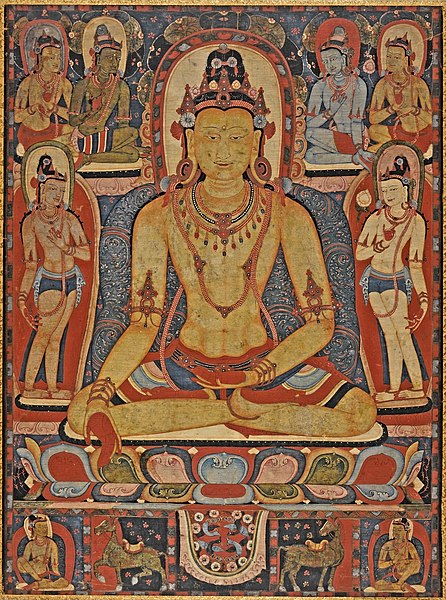Ratnasambhava is one of the Five Dhyani Buddhas of Mahayana and Vajrayana or Tantric Buddhism. Ratnasambhava's mandalas and mantras focus on developing equanimity and equality and, in Vajrayana Buddhist thought is associated with the attempt to destroy greed and pride. His consort is Mamaki and his mount is a horse or a pair of lions.
Ming dynasty (1368-1644) statue of Ratnasambhava in Huayan Temple in Datong, Shanxi, China, one out of a set of statues of the Five Tathāgatas
Jin Dynasty (1115–1234) statue of Ratnasambhava in Shanhua Temple in Datong, Shanxi, China, one out of a set of statues of the Five Tathāgatas
Ratnasambhava, around 1200, Los Angeles County Museum of Art
In Mahayana and Vajrayana Buddhism, the Five Tathāgatas or Five Wisdom Tathāgatas, the Five Great Buddhas, the Five Dhyani Buddhas and the Five Jinas, are five Buddhas which are often venerated together. Various sources provide different names for these Buddhas, though the most common today are: Akshobhya, Ratnasambhava, Vairocana, Amitābha, and Amoghasiddhi.
Jin Dynasty (1115–1234) statues of the Five Tathagathas in Shanhua Temple in Datong, Shanxi, China. From left to right: Amoghasiddhi, Amitābha, Vairocana, Ratnasambhava, Akshobhya
The Garbhadhatu Mandala depicts the adibuddha Vairochana, surrounded by four Buddhas (golden) and four Bodhisattvas (white); clockwise from top: Ratnaketu, Samantabhadra, Samkusumitaraja, Manjushri, Amitabha, Avalokiteshvara, Divyadundhubhimeghanirghosa, Maitreya.
Jin Dynasty (1115–1234) statue of Amoghasiddhi in Shanhua Temple in Datong, Shanxi, China
Jin Dynasty (1115–1234) statue of Amitabha in Shanhua Temple in Datong, Shanxi, China







